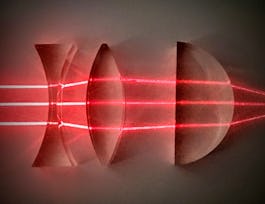Light is one of our most valuable resources on this earth. It makes the world visible to us, is the major driver of the 24-hr sleep-wake cycle to which not only humans, but virtually all life on earth (fauna and flora) submits. In fact, there would be no life on earth without light. It is therefore hard to overestimate the impact light has on humans, biologically, psychologically, socially. And yet, we hardly ever think or speak about light.



Details to know

Add to your LinkedIn profile
6 assignments
September 2024
See how employees at top companies are mastering in-demand skills


Earn a career certificate
Add this credential to your LinkedIn profile, resume, or CV
Share it on social media and in your performance review

There are 7 modules in this course
It is hard to overestimate the impact light has on humans, biologically, psychologically, socially. And yet, we hardly ever think or speak about light. We created four online courses, which cover fundamentals of the eye and brain (1), basic concepts of light, cognition, attention and sleep (2), effects and implications in outdoor conditions (3) and effects and implications for indoor lighting (4). This third course, LIGHTCAP 3 “Light in outdoor contexts” explores the principles of lighting and its effects on humans in various outdoor settings from the perspectives of pedestrians and drivers, covering topics such as alertness, wakefulness and attentiveness, but also feelings of safety and aesthetics. The basis of this course is predominantly in (environmental) psychology.
What's included
2 videos4 readings
In this first lecture, Richard will describe traditional methods of measuring feelings of safety in urban environment. We will also introduce novel approaches to the perceived safety assessment, such as 1) measuring arousal, both in its intensity as well as in its nature, 2) present the evolutionary approach to anxiety and its measurement. We will discuss possible issues around urban lighting and safety, such as individual needs, specific spaces or individual history.
What's included
3 videos1 assignment
In this lecture, Aysheh continues on the themes of pedestrian safety and alertness. Road lighting is of benefit to road users after dark. A well-designed road lighting must provide the amount of light that allows pedestrians to proceed safely. This lecture will introduce the lighting standards of minor roads, and the main purposes of road lighting. Explore the relation between light and Alertness, how it could be assessed, and highlight how it may be beneficial for pedestrians.
What's included
3 videos1 assignment
In this lecture, Nima will describe the fundamentals of cognitive workload and its relation to the driver's performance. The driving task will be described in detail and different sources of driver's overload and underload will be discussed. different measurement techniques of cognitive workload will be presented. Finally, road lighting's potential to improve drivers' cognitive performance will be highlighted.
What's included
3 videos1 assignment
In lecture 4, Richard reflects on how urban lighting design can stimulate attention. We will explain the concepts of alertness and mystery and discuss attention and its role in perception. We’ll introduce environmental psychology approach and some of its concepts and theories, such as place attachment and attention restoration theory. Students will explore the link between environmental aesthetics and attention, as well as possible future relationships and uses.
What's included
3 videos1 assignment
In this lecture, Nima will provide a brief summary of advancements in road lighting installations. It will aim to highlight the main changes requires to preserve the benefits of road lighting while minimizing energy consumption. These changes will be argued in four sections technology, pattern of use, standards and contracts, and the basis of design. Section 1 (technology) will cover currently available light sources, control gear, luminaires, and the electricity supply. Section 2 (pattern of use) argues the previous switching set-ups and potential changes. The advantages of real-time monitoring and control will also be discussed. Section 3 (standards and contracts) argues the basis of road lighting standards in the UK and across the globe, the reasons behind the selection of specific light set-ups and the future changes which need to be implemented will also be discussed. Section 4 (the basis of design) discusses the specific applications of road lighting design and how the design might be changed to best achieves the aims road lighting is designed for.
What's included
3 videos1 assignment
In this lecture, Aysheh reflects on the environmental impact of outdoor lighting. If the outdoor lighting is not carefully designed the unwanted effect can easily exceed the positive impacts. This lecture aims to address the possible adverse impact of outdoor lighting; mainly Light pollution, such as glare and skyglow, and describe its impact on people’s lives and wildlife.
What's included
4 videos1 assignment
Instructor

Offered by
Why people choose Coursera for their career




Recommended if you're interested in Health

Tecnológico de Monterrey

University of California, Davis

University of Colorado Boulder

Dartmouth College

Open new doors with Coursera Plus
Unlimited access to 10,000+ world-class courses, hands-on projects, and job-ready certificate programs - all included in your subscription
Advance your career with an online degree
Earn a degree from world-class universities - 100% online
Join over 3,400 global companies that choose Coursera for Business
Upskill your employees to excel in the digital economy


